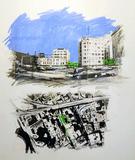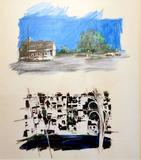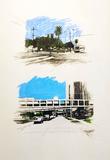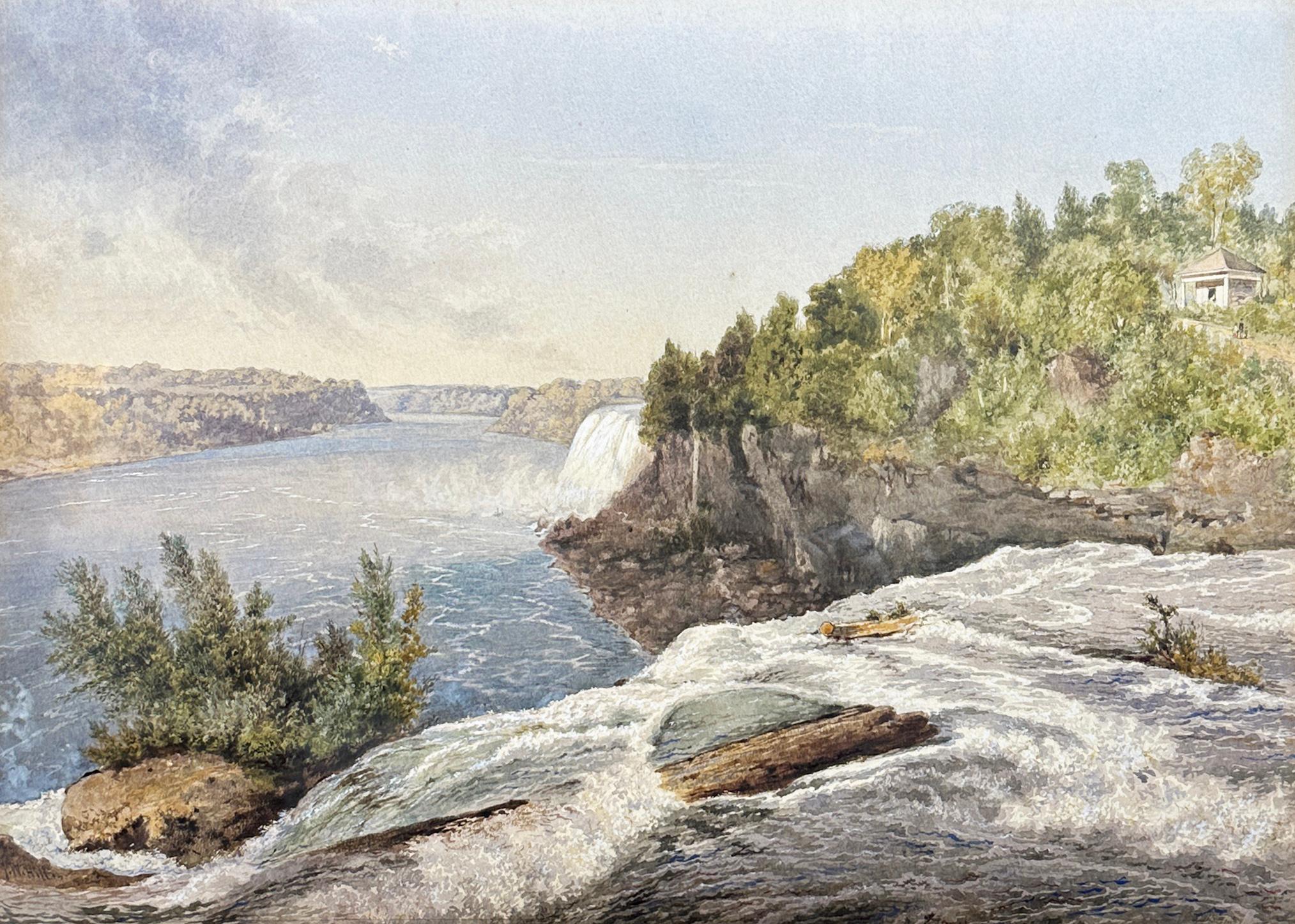Items Similar to Alpine Mountain
Video Loading
Want more images or videos?
Request additional images or videos from the seller
1 of 10
Edgar PayneAlpine Mountain
About the Item
Alpine Mountain
By. Edgar Alwyn Payne (American, 1882-1947)
Unframed: 13 x 13 inches
Framed: 20.5 x 21.5"
Born in Washburn, Missouri, Edgar Payne became one of the foremost plein-air landscape painters of California in the early 20th century. He is best known for his majestic Sierra Nevada Mountain scenes, and depicted so many Indians on horseback riding through the Sierra Nevada Mountains that a mountain lake, Lake Payne, was named for him. He painted many works "en plein air" and also did numerous sketches from which he later did studio paintings. He worked quickly and completed about one painting per day. He depicted many other locations as well including the coast of Laguna Beach, the Canadian Rockies, the French and Swiss Alps, the Italian and French Riviera, fishing scenes of Italy and France, and landscapes in the Southwest including the Grand Canyon and Canyon de Chelly in Arizona.
Payne was active in Chicago early in his career and there had a distinguished reputation for painting stage scenery for famous actresses and for mural painting.
He left home at age 14 because his father objected so strongly to his son's dedication to an art career. He earned money painting houses, stage sets and murals, and traveled through the Ozarks, Texas, Mexico and Chicago where he received a major commission from the Congress Hotel for an 11,000 foot mural of Italian gardens. (Since destroyed). In Chicago, he was active with the Chicago Society of Artists and the Alumni Association of the Art Institute.
He was self-taught except for a brief period at the Art Institute of Chicago. Of his art education, his daughter said: "My father never studied with anyone. He tried the Chicago Art Institute for a little while, but he didn't like it. He considered himself to be completely self-taught." ("Plein Air" 26)
In 1909, he first visited California and painted scenes of Laguna Beach and San Francisco. During this time he discovered the beauty of the Sierra Nevada mountains, where he returned continually throughout his career for the inspiration that led to his signature paintings and a turning from murals and stage sets to landscape painting.
He married artist Elsie Palmer in 1912, and the couple with their daughter, Evelyn, born in 1914, moved to Laguna Beach. They rented a beach-side cottage while Edgar built a home, which was the only one the family ever owned. They lived in it for three years, and it was a uniquely stable time for the family that traveled frequently in search of painting subjects.
Payne decided he wanted to have an art gallery for exhibiting artists, and in 1920 he became the founder and first president of the Laguna Beach Art Association and the Gallery of Laguna Beach. The first meeting was held in his studio. The Paynes later moved to Los Angeles so they could be closer to the Stendahl Galleries, which was in the Ambassador Hotel and represented his work.
In 1916, the Santa Fe Railroad commissioned him to paint the Southwest, and the couple spent four months in Canyon de Chelly. They also traveled and sketched the Grand Canyon and scenes of New Mexico and spent several years, 1922 to 1924, in Europe. Payne had a commercial artist friend, George Evans, who visited them in Europe, and according to Payne's daughter, Evans and the Paynes spent much time looking at artwork in museum. In the 1923 Paris Salon, Payne won an Honorable Mention, which was significant recognition because more than 7000 paintings were exhibited.
During the Depression, Payne took teaching jobs to earn money for him and his family, and he also wrote his book, "Composition of Outdoor Painting", which, with many printings, has been a popular guide to landscape painting. He and his wife continued to spend much time in New York City and had planned to build a house there, but did not start the project because of the economy.
The couple separated in 1932, but Elsie, who subsequently had a very successful career, returned to live with him towards the end of his life when he was ill. A major problem between them was his dominant personality and her resentment that her own considerable talents were submerged by his demands. Apparently he felt remorse. Their daughter wrote that "the last words her father spoke to her on his last day of life in 1947 were that 'he was sorry he had been so selfish and that everything had been for his art.' " ("Plein Air" 26)
ASSOCIATIONS:
Salmagundi Club
Allied Art Association
International Society Art League
California Art Club (President 1926)
Laguna Beach Art Association
Ten Painters of Los Angeles
Palette & Chisel Club, 1913
Chicago Society of Artists
American Artists Professional League
Carmel Art Association
EXHIBITIONS:
California State Fairs, 1917 (prize),1918 (prize)
Sacramento State Fair, 1918 (gold)
Sacramento, 1919 (medal)
Los Angeles County Museum of Art, 1919 (solo), 1926 (gold medal)
Art Institute of Chicago, 1920 (prize)
Southwest Museum, 1921 (prize)
Pennsylvania Academy of Fine Arts Annual,1921,22,25
Paris Salon, 1923
National Academy of Design, 1929 (prize)
Golden Gate International Exposition, 1939
California Art Club, 1947 (prize).
PUBLIC COLLECTIONS: Murals
Empress Theatre & American Theatre, Chicago
Clay County Court House, Brazil, IN
Hendricks County Court House, Danville, IN
Queen Theatre, Houston
PUBLIC COLLECTIONS: Paintings
Nebraska Art Association, Lincoln
Peoria Society of Allied Artists
Herron Art Institute
Municipal Art Commission
Janesville (WI) Art Association
Indianapolis Museum
Laguna Art Museum
Bancroft Library, UC Berkeley
National Academy of Design
National Museum of American Art, Washington D.C.
Pasadena Art Institute
Pasadena Art Museum
Southwest Museum of Los Angeles
Springville (UT) Museum of Art
University of Nebraska Galleries
Art Institute of Chicago
Oakland Museum; Irvine Museum, CA
Fleischer Museum, Scottsdale, AZ
- Creator:Edgar Payne (1883 - 1947, American)
- Dimensions:Height: 13 in (33.02 cm)Width: 13 in (33.02 cm)
- Medium:
- Movement & Style:
- Period:
- Condition:
- Gallery Location:Missouri, MO
- Reference Number:1stDibs: LU747312199902
About the Seller
5.0
Vetted Seller
These experienced sellers undergo a comprehensive evaluation by our team of in-house experts.
Established in 1970
1stDibs seller since 2017
141 sales on 1stDibs
Typical response time: 21 hours
- ShippingRetrieving quote...Ships From: Missouri, MO
- Return PolicyA return for this item may be initiated within 2 days of delivery.
More From This SellerView All
- Hudson River WaterfallBy John William HillLocated in Missouri, MOHudson River Valley with Waterfall By. John William Hill (English, American, 1812-1879) Signed Lower Left Unframed: 14" x 19" Framed: 23" x 28.5" John William Hill was the son of the British aquatint engraver John Hill and the father of John Henry Hill. He immigrated with his family to this country in 1819. He was apprenticed to his father in 1822 when his family moved from Philadelphia to New York City. In 1833, by the age of 21, he was elected an associate of the National Academy of Design. Early in his career he was a topographical artist employed by the New York State Geological Survey and later by Smith Brothers of New York City, for whom he made watercolor views of many American cities. About 1855, Hill read Ruskin’s Modern Painters and became interested in the American Pre-Raphaelite Movement of which he came to be considered the leading spirit in America. A versatile artist, he worked in lithography, aquatint, and watercolor. He made detailed pictures directly from nature, many in watercolor and executed in a stipple technique with tiny brushes normally employed for miniatures. He exhibited at the National Academy of Design from 1829 until his death and also at the Brooklyn Art...Category
19th Century Land Landscape Drawings and Watercolors
MaterialsWatercolor, Gouache
- A Beautiful DayBy Nellie Mae RoweLocated in Missouri, MOA Beautiful Day, 1978 by Nellie Mae Rowe (American, 1900-1982) Unframed: 9" x 12" Framed: 11.25" x 14.25" Signed and Dated Lower Left Nellie Mae Rowe ...Category
20th Century Folk Art Abstract Drawings and Watercolors
MaterialsCrayon, Pastel, Paper, Graphite
- Les Usines En BanlieueBy Maurice UtrilloLocated in Missouri, MO"Les Usines En Banlieue" 1926 Gouache 31 x 40cm/approx. 12.5 x 16.75 inches Signed and Dated Lower Right Catalogue Raisonne: Petredies, Plate AG166, Page 190-191Category
1920s Impressionist Landscape Drawings and Watercolors
MaterialsGouache
- Winter Landscape 1938Located in Missouri, MOMonogrammed Lower Right and Dated 1938 This is by the stage designer, Walter Kubbernuus, for the opera Katyusha by Franco Alfano. After Tolstoi. Monogrammed Lower Right.Category
Early 20th Century Landscape Drawings and Watercolors
MaterialsGouache
- Old Mission Station, San Francisco, CaliforniaBy Dong KingmanLocated in Missouri, MODong Kingman (American 1911-2000) "Old Mission Station" c. 1950 watercolor on paper Signed *Fully illustrated in the book "Dong Kingman, Portraits of Cities" Sheet Size: 22 x 30 inches Framed Size: 32.5 x 40.5 inches The following obituary is from Dong Kingman Jr., son of the artist. DONG KINGMAN (1911-2000) Dong Kingman, the world-renowned artist and teacher, died in his sleep on May 12, 2000 at age 89 in his home in Manhattan. The cause was pancreatic cancer. Long acknowledged as an American watercolor master, he has received an extraordinary number of awards and honors throughout his 70-year career in the arts. Included are two Guggenheim fellowships in 1942 and 1943; the San Francisco Art Association First Purchase Prize, 1936; Audubon Artist Medal of Honor, 1946; Philadelphia Watercolor Club Joseph Pennel Memorial Medal, 1950; Metropolitan Museum of Art Award, and the National Academy Design 150th Anniversary Gold Medal Award, 1975. In 1987, the American Watercolor Society awarded Dong Kingman its highest honor, the Dolphin Medal, "for having made outstanding contributions to art especially to that of watercolor." His work is represented in the permanent collections of 50 museums and universities, including the Boston Museum of Fine Arts, M.H. deYoung Memorial Museum of Art, the Metropolitan Museum of Art, the Whitney Museum, Museum of Modern Art, Art Institute of Chicago, Pennsylvania Academy of Fine Arts, Sheldon Memorial Art Gallery and Sculpture Garden, Des Moines Art Center, Columbus Museum of Arts and Crafts, Brooklyn Museum and Hirshhorn Museum. Born in Oakland, California in 1911 of Chinese descent, Kingman moved to Hong Kong at age five. He studied art and calligraphy in his formative years at the Lingnan School. The painting master Szeto Wai had recently studied art in Paris and took a keen interest in young Dongs precocious talents. He taught him both Chinese classical and French Impressionist styles of painting. Kingman returned home to Oakland when he was 18 at the height of the Depression. He worked as a newsboy and dishwasher to make ends meet. When he was employed as a houseboy for the Drew family in San Francisco, he painted every spare moment. In a year, he created enough pictures to have a one-man show at the Art Center. It attracted the attention of San Francisco art critics who raved about Kingmans unique style. Wrote Junius Cravens of the San Francisco News: "That young Chinese artist is showing 20 of the freshest and most satisfying watercolors that have been seen hereabouts in many a day Kingman already has developed that universal quality which may place a sincere artist work above the limitations of either racial characteristics or schools. Kingmans art belongs to the world at large today." Dong Kingman became an overnight success. From 1936 to 1941, he was a project artist for WPA and became a pioneer for a new school of painting, the "California Style." His two Guggenheim fellowships enabled him to travel the country painting American scenes. His first one-man show in New York at Midtown Galleries in 1942 was well received in the media, including Time, Newsweek, the New Yorker and American Artist. M.H. de Young Memorial Museum in San Francisco held a major exhibit of his watercolors in 1945. In 1951, Midtown presented a 10-year retrospective of his work. Time Magazine wrote, "At age 40, Kingman is one of the worlds best watercolorists." Other retrospectives, including Corcoran in Washington,D.C. an d Witte Memorial Museum in San Antonio, were held for the artist. Kingman moved to Wildenstein (1958-1969) where he had successful exhibits in New York, London and Paris. Hammer Galleries exhibited his paintings in the 70s, and then the artist expanded his venues to the West Coast and Far East. During World War II, he served with the OSS in Washington, D.C. where he was a cartographer. After his honorable discharge, Kingman moved to Brooklyn Heights from San Francisco when he became a guest lecturer and then art instructor at Columbia University (1946-1958). Hunter College also appointed him instructor in watercolors and Chinese Art (1948-1953). His teaching career continued with the Famous Artists School, Westport, CT in 1953, joining such distinguished artists on the faculty as Will Barnet, Stuart Davis, Norman Rockwell and Ben Shahn. He also became a teaching member for 40 years for the Hewitt Painting Workshops, which conducts worldwide painting tours. He taught at the Academy of Art College in San Francisco, was a member of its board, and received an honorary doctorate from the Academy. In 1954, the U.S. Department of State invited Kingman to go on a cultural exchange program tour around the world to give exhibitions and lectures and to meet local artists. When he came home, he presented the State Department with a 40-foot long report on a scroll, which later appeared in LIFE Magazine. One of Kingman's most treasured experiences was his invitation by the Ministry of Culture of the Peoples Republic of China to exhibit in that country in 1981. He was the first American artist to be accorded a one-man show since diplomatic relations resumed. More than 100,000 visitors attended his exhibitions in Beijing, Hangzhou and Guangzhou and the retrospective received critical acclaim from the Chinese press. Noted the China Daily Mail, "Just as the master painters of the Song Dynasty roamed about mountain and stream to capture the rhythm of nature, Dong Kingman traveled the world capturing the dynamism of modern lifefamiliar scenes have been transformed into a vibrant new vision of life through color schemes with rhythms that play over the entire surface of the picture. The wind swept skies which enliven his watercolors remind us of the pleinairism of the French Impressionists." Kingman, who has been fascinated with movies since seeing his first film "The Thief of Baghdad...Category
1950s American Modern Landscape Drawings and Watercolors
MaterialsWatercolor
- Winter Cabin Scene 1938Located in Missouri, MOThis is by the stage designer, Walter Kubbernuus, for the opera Katyusha by Franco Alfano. After Tolstoi. See attached image of the writing of the verso. Monogrammed Lower Right. ...Category
Early 20th Century Landscape Drawings and Watercolors
MaterialsGouache
You May Also Like
- United States Capitol in Space, PinkBy Grover MoutonLocated in New Orleans, LAArchitect and artist Grover Mouton brings utilizes hand drawings to illustrate urban design proposals. Acting as a catalyst to explore design concepts, Mouton's works on paper demons...Category
21st Century and Contemporary Land Landscape Drawings and Watercolors
MaterialsOil Crayon, Mixed Media, Color Pencil, Graphite
- Medical Center Master Plan, New Orleans 2By Grover MoutonLocated in New Orleans, LAArchitect and artist Grover Mouton brings utilizes hand drawings to illustrate urban design proposals. Acting as a catalyst to explore design concepts, Mouton's works on paper demons...Category
21st Century and Contemporary Land Landscape Drawings and Watercolors
MaterialsColor Pencil, Graphite
- Master Plan Study, MonroeBy Grover MoutonLocated in New Orleans, LAArchitect and artist Grover Mouton brings utilizes hand drawings to illustrate urban design proposals. Acting as a catalyst to explore design concepts, Mouton's works on paper demons...Category
21st Century and Contemporary Land Landscape Drawings and Watercolors
MaterialsGraphite, Mixed Media, Color Pencil
- Medical Center Master Plan, New Orleans 1By Grover MoutonLocated in New Orleans, LAArchitect and artist Grover Mouton brings utilizes hand drawings to illustrate urban design proposals. Acting as a catalyst to explore design concepts, Mouton's works on paper demons...Category
21st Century and Contemporary Land Landscape Drawings and Watercolors
MaterialsMixed Media, Color Pencil, Graphite
- Original Oil Painting of the Mountainous West Coast of Ireland by Irish ArtistLocated in Preston, GBOriginal Oil Painting of the Mountainous West Coast of Ireland by Irish Artist, John Ginn Art measures 30 x 20 inchesCategory
Late 20th Century Land Landscape Paintings
MaterialsCanvas, Oil
- Great Gable & Buttermere in English Lake District by 20th Century British ArtistBy Arthur Terry BlamiresLocated in Preston, GBOil Painting of Great Gable & the Buttermere Fells in English Lake District by 20th Century Modern British Landscape Artist, Arthur Terry Blamires (b. 1930) Art measures 30 x 20 inc...Category
1980s Land Landscape Paintings
MaterialsOil, Board





